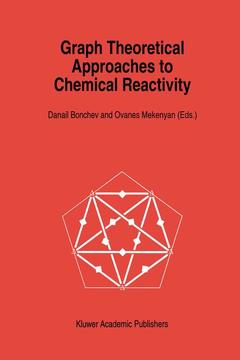Graph Theoretical Approaches to Chemical Reactivity, 1994 Understanding Chemical Reactivity Series, Vol. 9
Langue : Anglais
Coordonnateurs : Bonchev Danail D., Mekenyan O.G.

The progress in computer technology during the last 10-15 years has enabled the performance of ever more precise quantum mechanical calculations related to structure and interactions of chemical compounds. However, the qualitative models relating electronic structure to molecular geometry have not progressed at the same pace. There is a continuing need in chemistry for simple concepts and qualitatively clear pictures that are also quantitatively comparable to ab initio quantum chemical calculations. Topological methods and, more specifically, graph theory as a fixed-point topology, provide in principle a chance to fill this gap. With its more than 100 years of applications to chemistry, graph theory has proven to be of vital importance as the most natural language of chemistry. The explosive development of chemical graph theory during the last 20 years has increasingly overlapped with quantum chemistry. Besides contributing to the solution of various problems in theoretical chemistry, this development indicates that topology is an underlying principle that explains the success of quantum mechanics and goes beyond it, thus promising to bear more fruit in the future.
1. Introduction to Graph Theory.- 1. Chemical Graph Theory.- 2. Representation and Characterization of a Graph.- 3. Realization of a Graph.- 4. Operations on Graphs.- 5. References.- 2. The Interplay Between Graph Theory and Molecular Orbital Theory.- 1. Introduction.- 2. Fundamentals of Graph Theory.- 3. Isomorphism of Graph Spectral Theory and Hückel Molecular Orbital Theory.- 4. Hückel Spectrum.- 5. Topological Effect on Molecular Orbitals.- 6. The HOMO-LUMO Separation.- 7. Topological Charge Stabilization.- 8. Localization Energy.- 9. Concluding Remarks.- 10. References.- 3. Topological Control of Molecular Orbital Theory:A Comparison of µ2-Scaled HüCkel Theory and Restricted Hartree-Fock Theory for Boranes and Carboranes.- 1. Introduction.- 2. Calculational Method.- 3. The Method of Moments.- 4. Elemental Boron.- 5. BnHn2-Clusters.- 6. The ?-Parameter of B10H102-.- 7. Reaction Pathways.- 8. Conclusion.- 9. References.- 4. Polyhedral Dynamics.- 1. Introduction.- 2. The Topology of Polyhedra.- 3. Polyhedral Isomerizations.- 4. Microscopic Models: Diamond-Square-Diamond Processes and Gale Diagrams.- 5. Macroscopic Models: Topological Representations.- 6. Literature References.- 5. Reaction Graphs.- 1. Introduction.- 2. Reaction Graphs of Rearrangements Via Carbocations.- 3. Automerization of Bulvalene, Other Valence Isomers of Annulenes,and Azabullvalene.- 4. Rotation in Molecular Propellers.- 5. Reaction Graphs for Rearrangements of Metallic Complexes.- 6. Xenon Hexafluoride.- 7. Heptaphosphide Trianion.- 8. Kinetic Graphs, Synthon Graphs, and Graph Transforms.- 9. Conclusions.- 10. References.- 6. Discrete Representations of Three-Dimensional Molecular Bodies and Their Shape Changes in Chemical Reactions.- 1. Introduction and Review of Basic TopologicalConcepts of Molecular Shape Representation.- 2. Molecular Shape Representation by Nuclear Potential Contours(NUPCO’s).- 3. Topological Patterns of NUPCO Sequences.- 4. Shape Changes of NUPCO Sequences Along Reaction Paths and in Conformational Domains.- 5. Shape Changes of NUPCO’s in Conformational Changes and inMolecular Deformations; NUPCO Shape Invariance Domains of the Configuration Space.- 6. Local Shape Invariance of NUPCO’s and the Transfer of FunctionalGroups in Chemical Reactions.- 7. Summary.- 8. References.- 7. The Invariance of Molecular Topology in Chemical Reactions.- 1. Introduction.- 2. From a Lewis Diagram to the Pseudo-Graph and Graphoid.- 3. From Graph (Graphoid) to Surface.- 4. What Is the Topological Homeomorphism from the Chemical Pointof View?.- 5. The Invariance of the Euler Characteristic in Chemical Reactions.- 6. The Main Theorem.- 7. Conclusion.- 8. References and Notes.- 8. Topological Indices and Chemical Reactivity.- 1. Introduction.- 2. Basic Principles Underlying the Topological Nature of Chemical Reactivity.- 3. Molecular Topology and Topological Invariants.- 4. Applications of Topological Indices to Chemical Reactivity.- 5. Conclusions.- 6. References.- 9. Graph-Theoretical Models of Complex Reaction Mechanisms and Their Elementary Steps.- 1. Introduction.- 2. Graph-Theoretical Approach to Studies in the Elementary Stepsof Complex Reactions.- 3. Classification and Coding of Linear Reaction Mechanisms By UsingKinetic Graphs.- 4. Application of Bipartite Graphs and Stoichiometric Matrices to theDescription of Linear and Nonlinear Reaction Mechanisms.- 5. Topological Aspects of Complex Reaction Mechanisms.- 6. References.
Date de parution : 10-2012
Ouvrage de 283 p.
16x24 cm
Thèmes de Graph Theoretical Approaches to Chemical Reactivity :
Mots-clés :
chemical reaction; graph theory; inorganic chemistry; patterns; structure
© 2024 LAVOISIER S.A.S.



